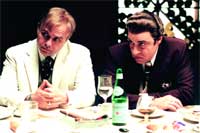
Over 100,000 feet of Sopranos footage is transferred per episode on Riot's Thomson DataCine.
|
SANTA MONICA - Since 1999, HBO's The Sopranos has unnerved and delighted audiences with engrossing tales of dysfunctional wiseguys and their codependent families. From season one, veteran A.C.E. editors, Sidney Wolinsky, Conrad Gonzalez and William Stich, have been cutting this controversial drama. After the current fourth season - which is shooting on 35mm but is cablecast in HD - is finished they will have collectively cut 52 episodes of The Sopranos from over five million feet of footage.
Producer/writer/creator David Chase (The Rockford Files, Northern Exposure) can be called the "Godfather" of the show. He created the series out of a development deal he had with Brillstein-Gray Entertainment, pens many of the scripts and oversees every aspect of the production and post.
"He's in charge of the show from the script to hearing the final mix of the sound," says Sopranos producer Martin Bruestle. Chase hand picked each of the editors just as the first season was starting production in the summer of 1998.
THE EDITORS
"I had cut a movie-of-the-week for David called Almost Grown in 1988," recalls Wolinsky. "When he got The Sopranos he called and asked if I was interested, and I decided I was."
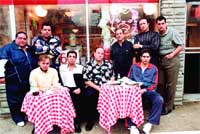
The Sopranos is offlined on Avid Meridien machines. Online is nonlinear HD via Discreet Fire.
|
Wolinsky started his career with a passion for movies but was not quite sure what to do. "I had a degree in English and was a film nut. I got a Masters degree in film from San Francisco State and was thinking of editing." He remembers cutting AFI student projects and working as an assistant editor to Richard Marks, a multiple Oscar-nominated editor - for As Good As It Gets, Broadcast News, Terms of Endearment - and eventually got the opportunity to edit a little bit. "I watched him cut two feature films, The Hand, Oliver Stone's first feature, and Herbert Ross's Pennies From Heaven."
William Stich also had a history with Chase. "I had worked with David on I'll Fly Away recalls Stich, "I got a tape of The Sopranos pilot and thought it was interesting, intriguing. Because it's an HBO show they let you do a lot more in the sense of sex, violence and rock and roll."
Stich graduated from USC Film School and learned his craft from a slew of television editors who had come from the feature world: Bob Swanson, Michael Vejar, Dave Wages and Carl Pingitore. "Basically what they did is give you scenes to cut as an assistant and we would review them. Carl was a producer on Fantasy Island. He cut Dirty Harry and Play Misty for Me. I learned a lot.."
Conrad Gonzalez says he just got lucky. "David Chase had worked with another editor, Tom Moore, on Northern Exposure and offered him the position on The Sopranos. However Tom had just finished the first season on Ally McBeal, which was a big hit, and he didn't want to risk leaving that. So he threw my name into the hat.
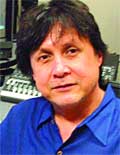
Conrad Gonzalez
|
"David saw on my resume," continues Gonzalez, "that I had edited a couple of art films: Martin Donovan's Apartment Zero, a psychological thriller, and Percy Adlon's Salmonberries. He really liked those films. They interviewed 12 people and I got the job."
Gonzalez went to film school at Loyola Marymount. He got to assist feature editor C. Timothy O'Meara, whose film cutting credits include Conan the Barbarian, Hoosiers and The Rose. "Tim was a great editor," comments Gonzalez, "he would let me be in the room as much as possible. I learned a lot through osmosis."
FROM FILM TO DIGITS
Runway Video (www.runway.com) in Culver City, CA, provides four offline Avid Meridien systems for the show: one for each editor and the fourth shared by the assistant editors. The Avids run on Macintosh G4s with an 867MHz chip. The four systems are tied to a Unity shared storage network with 633 GB of memory - enough to hold over 140 hours of footage at the 28:1 compression that they use.
All three of The Sopranos editors have made the choppy transition from cutting on film to nonlinear. All agreed it was purely survival that motivated them to master the new technology.
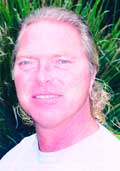
William Stich
|
Says Wolinsky, "I got tired of phone calls that said, 'Can you edit on the Montage?' No. 'Oh, sorry.'" All three editors have been cutting on the Avid since the early '90s.
They all acknowledge that editing on a nonlinear computer system is better than the old-fashioned way: they can cut scenes together faster, experiment more with different cuts of a scene and achieve a more finished look. However, the downside to this scenario is that producers expect more from the picture editor. "They all know we have eight tracks of audio on the system, so now they expect the music and sound effects, and opticals," says Wolinsky. "We now create the template for the online opticals and the sound mix."
Wolinsky points to the first show of the second season as an example: "There's a scene where Pussy is at a [backyard] barbeque and Tony is having one of his pre-panic attacks. I wanted a roar and concocted some effect with the sound of an airplane taking off. I meant the effect to be temporary and to give an idea to the sound guys. So I get a call. David wants the mix to sound like those tracks. The sound guys from Todd-AO came over and looked at my tracks. Now we send them OMF files so that whatever we do audio wise on the Avid can be translated directly to their tracks."
Being able to dramatically manipulate the image is another positive advantage to the digital system. Gonzalez takes advantage of the fact that The Sopranos is posted in HD. "One of the great things about having an HD master," says Gonzalez, "is - because the resolution is so high - you can do extreme blow-ups and not tell they are blow-ups.In the past if you blew anything up past 10 percent it would get murky. In one situation there was a full shot - the director thought he shot a close-up, but he didn't.I did a 60 to 75 percent blow-up to get the close-up, not going back to the negative, and no one was the wiser."
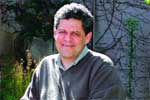
Sidney Wolinsky
|
THE STYLE
Do these guys think The Sopranos has an editing style? "David really set the tone of the show when he directed the pilot, for which he won a DGA [Directors Guild of America] award," says Bruestle.
"Everything was about connecting to the tone of the material," he continues. "It was a comedy, but it operated on multiple levels. In their conversations you get a connection with the editor - they understand what you are trying to accomplish thematically."
"In a lot of ways The Sopranos is a conventional show," says Stich. "We don't use a lot of swish pans, we don't use a lot of Steadicam that you cut from movement to movement constantly. Not a lot of quick cuts here and there. It's basic good filmmaking. Shooting your master, shooting your over-the-shoulders, shooting your close-ups and having good composition. And you don't have to over stylize something because you have a good script."
"The Sopranos is a conventional show," echoes Gonzalez. "We do not do super stylish editing. It has a style, but it's a unique style unto itself. It's a dialogue-driven show, so the style is very linear. All three editors have pressed the limits, taking moments, playing the moments, but also really cutting the dialogue tight. The shows really move. They don't plod along. It's a tempo and a pace that we put on the shows that you probably wouldn't be aware of unless you were an editor."
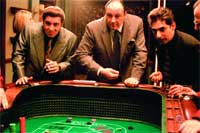
Shot on 35mm film, this series is mastered to HD and cablecast.
|
"My impression is that when people hire editors," explains Wolinsky, "is that it seems to be less about style and more about, 'Are they in sync with that person?'"
THE WORKFLOW
The Sopranos is shot on location throughout New Jersey and on the soundstages of Silvercup Studios (www.silvercupstudios. com) in New York City. The undeveloped negative is sent back to Los Angeles where all the post production - telecine, picture editing, sound mixing and sound editorial - is done, overseen by Bruestle.
He and the editing team are set up in offices across the street from Riot (www.rioting.com) in Santa Monica, where they do their film-to-tape transfers and online post.
The Sopranos transfers about 100,000 feet of film per episode at Riot. The transfers are done 1080i on the Thomson Spirit DataCine to a AJ-HD3700H Panasonic multiformat HD deck. The assistant editors load all the footage, from DVCAM dubs, onto the Unity system so everyone has access.
"I have several days to cut it and show it to the director," says Wolinsky, describing the process all three editors go through. "Then [the director] gets four days, contractually, to do what he wants. After that I could work on a show for months with David."
At Riot, the online edit is done completely in nonlinear HD on a Discreet Fire equipped with a whopping 1.2 TB of storage space. The Sopranos has been editing on the Fire since the third season, says Richard Cormier, managing director of Riot.
Cormier recalls that when the show's producers went to make DVD versions of their first two seasons, they decided to remaster the shows in HD, going back to the original negative and conforming it to the SD version of the show. In the third season they decided upfront to post and start cablecasting the shows in HD, and continue to shoot on 35mm Kodak Vision 5246 for exteriors, 5279 for interiors and 5284 in Melfi's office.
During the online session at Riot, it takes eight to 10 hours to conform the show to the Avid EDL and build a 1080psf/23.98 video assembled master (VAM). Dirt fixes are completed on the Fire and insert edited into the VAM. A revised VAM with opticals goes into a final color correction approval session and a new separate color corrected master (CCM) is generated. Titles and credits are added to the CCM which becomes the edited master (EM). After the finished audio mix from Todd-AO is laid back to the show at POP Sound HBO receives a clone of the 1080psf/23.98, a drop frame version of the 1080i/59.94 sweetened EM, and standard definition16:9 letterboxed and 4:3 dropframe Digi Beta copies made from the corresponding non-drop frame Digi Beta masters.
WISH list
Gonzalez says there are a few technical improvements that would make the job nicer. "None of these systems are set up with three channels. When we do temp mixes everything is blended together." They would have more control over the dialogue, he says, if they had a center channel for voice and separate music and effects on each side. He's also looking for improvements on the picture side. "We have a good working level digitized image, but it's not great. That was one of the good things about working with film. What you saw was 2,000 lines of resolution."